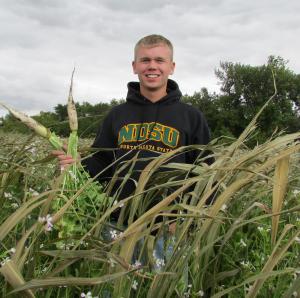Conservation Helps a Beginning Farmer in Walsh County
It isn’t easy getting started farming or ranching. Justin Zahradka, of Lawton, credits some of his early success as a beginning farmer to help from the USDA Natural Resources Conservation Service (NRCS).
Luann Dart writes from Elgin, N.D.
He’s received technical advice and guidance and financial assistance from NRCS to no-till, establish a rotational grazing system and utilize cover crops.

Zahradka got started farming on his own in 2011 when he was a junior in high school. At the same time that he leased 40 acres coming out of the Conservation Reserve Program (CRP), he learned that the Walsh County Three Rivers Soil Conservation District and the North Dakota State University (NDSU) Extension Service were looking for 40 acres for a cover crop demonstration project. They wanted to graze cattle on a full-season cover crop to study their weight gain.
Just 17-years-old at the time, Zahradka applied for the project and was selected. Working with NRCS and NDSU, he did multiple passes of tillage and planted a cover crop mix of radishes, turnips, sunflowers, field peas and sorghum sudan grass in July. His cattle grazed the cover crops in the fall. Calves gained an average of 1.5 to 2 pounds per day, while the cows gained about a pound a day. The weight gain grazing was double what cattle typically gain in a grass pasture in the fall.
Zahradka is farming about 500 acres today. He owns 16 stock cows; feeds the heifers and steers (selling the finished steers direct to consumers); and custom grazes cattle on his pastures, cover crops and crop residues. He continues working closely with NRCS on conservation practices that protect the water, air and soil and improve wildlife habitat.
Financial assistance for qualifying practices through the Environment Quality Incentive Program (EQIP) has been a big help, he says.
“There’s always some risk when you try something new.”
Adding cover crops
Zahradka grows wheat, canola and peas as cash crops. He follows each harvest with a cover crop. If he also intends to graze the cover crop, he plants a mixture of oats, peas, sorghum sudan grass, hairy vetch and turnips. Planting winter rye allows for early spring grazing on his tillable acres. Following wheat, he usually plants a cover crop of radishes and turnips with a grass or legume.
“We found out that if you just plant radishes and turnips alone, they actually have some soluble phosphorus they release when the snow melts in the spring that can actually cause more pollution than what you would normally without a cover crop, so you have to incorporate a grass into that mix,” he says.
Zahradka started no-till farming in 2015. It helped further reduce the risk of soil erosion and improved soil health.
“You can tell how healthy your soil is by the amount of carbon or organic matter that is in it,” he says. “Every soil test I’ve taken has measured the percent organic matter. For the past three years, I’ve been able to increase the organic matter percentage by 0.1. That doesn’t sound like a huge number, but the organic matter ranges I’m working are from 3.5 to 5%. For every percentage point that you can increase your organic matter, your soil can hold 27,000 gallons of water per acre and hundreds of pounds of nutrients as well.”
Rotational grazing
Zahradka has a rotational grazing system. He uses 50-acre pasture split into 10 to 20 acre paddocks. He moves cattle to a new paddock about once a week. This allows the grass to recover between grazing.
“I definitely noticed the increased grass production and increased nutrition. The first grass I grazed the beginning of June had two months recovery time, then I grazed that again in late September or early October and you’d have nice regrowth that’s in the vegetative state instead of having grass that’s all seeded out. You have fresh growth, more growth and increased weight gain on the cattle, because it’s more nutritious for them,” he says. The cattle are then moved to the cover crops to graze in late fall and early winter.
Advocating for conservation
Zahradka was elected to the board of the Three Rivers Soil Conservation District. He advocates for conservation and encourages others to use EQIP to try new practices.
“The nice part of EQIP is that you can do one acre, you can do 10 acres or up to 100 acres; it’s a small way to try something new and see if it can fit into your farming system.”
Rita Sveen, the NRCS District Conservationist in Walsh County, appreciates Zahradka’s willingness to promote soil health. The adoption of cover crops for soil heath is increasing Walsh County. She credits Justin and other cooperators, along with Brad Brummond, the NDSU Walsh County Extension agent, and the NRCS and SCD teams for the progress.
“We have a strong soil health partnership started in our county,” she says.


